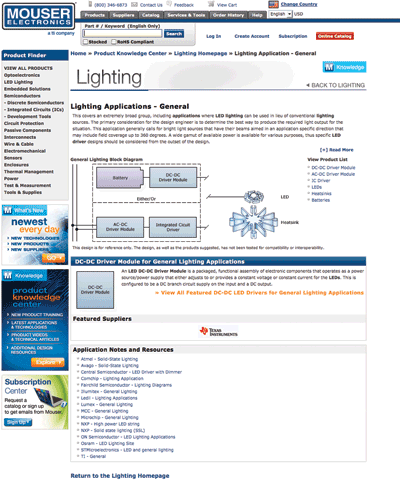We are in the midst of the automotive industry’s Auto Show season, with major events taking place in Detroit, Chicago, and New York City. One attractive feature of an auto show is the concept car, an opportunity that allows engineers and stylists to think in creative ways and explore ideas, technologies and styles – new concepts – that are technically feasible.
In that spirit I’d like to present a conceptual version of a distributor’s product website, something I would create to educate electronic design engineers on the features, advantages, and applications of the newest products from leading manufacturers.
Let’s start with how engineers typically go about finding parts. Usually the main goal is to select a part that minimizes the overall cost of the system while still fulfilling system specification (e.g., performance and reliability).
As such most engineers will probably begin with a well-defined set of system hardware requirements and then try to match those up against current offerings from different vendors in an attempt to find a part that has as many desirable features as possible. This usually involves searching through datasheets and supplier and distributor websites, but may also include peer consultations.
Applications would be a big part of my conceptual site because datasheets mainly concentrate on the raw functionality of a device's circuitry; details on function and setup alone will not inform a developer on how to use a particular feature of the part in an actual application. Let’s take lighting as an example. My concept site would provide links to tools and articles to help engineers predict system performance for uniform and non-uniform lighting projects, including the illumination at specific points in the target space. Provisions would be made to help the designer obtain and input lab photometric reports detailing each proposed luminaire’s characteristics. A detailed discussion would explain why, in practice, the light output of a luminaire can be higher or lower than the reference measurements in the laboratory.
To become a ‘destination site’ for engineers my concept must not only include compelling solutions but present these solutions in a web-conscious way that calls into play the power of the Internet. For example, my concept Web site not only will show new products up front but all of the applications-oriented pages will be navigable via block diagrams, with the components shown representing live links to product pages as well as application notes, tutorials, downloadable white papers, product videos and additional resources enabling the engineer to examine detailed technical information at his or her own pace.

My concept also would rely heavily on visual navigation, whether in application or product categories. What do I mean by that? For example, suppose you are looking for a capacitor. Beyond factual data you would be presented with images of various available package styles for different types of caps. Visual cues also would be added to each product section so that you can find individual features and specs more easily — images of different featured products appearing along with text when you use the search engine, potentially yielding parts that a design engineer would never have expected to use in a project because he or she was unaware of a new addition to the manufacturer's product line.
Concept cars are often shown at motor shows to gauge customer reaction to new designs, with features that may or may not have a chance of being produced. Does my concept of a distributor’s product Web site, or some elements of it, have a chance of seeing the light of day? Yes, there is a happy ending here. I expect to see great things from Mouser's site in the near future, and you can further anticipate that these developments will be detailed in future editions of “Distribution for Engineers.” ■
Advertisement
Learn more about Mouser Electronics





